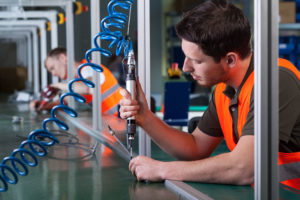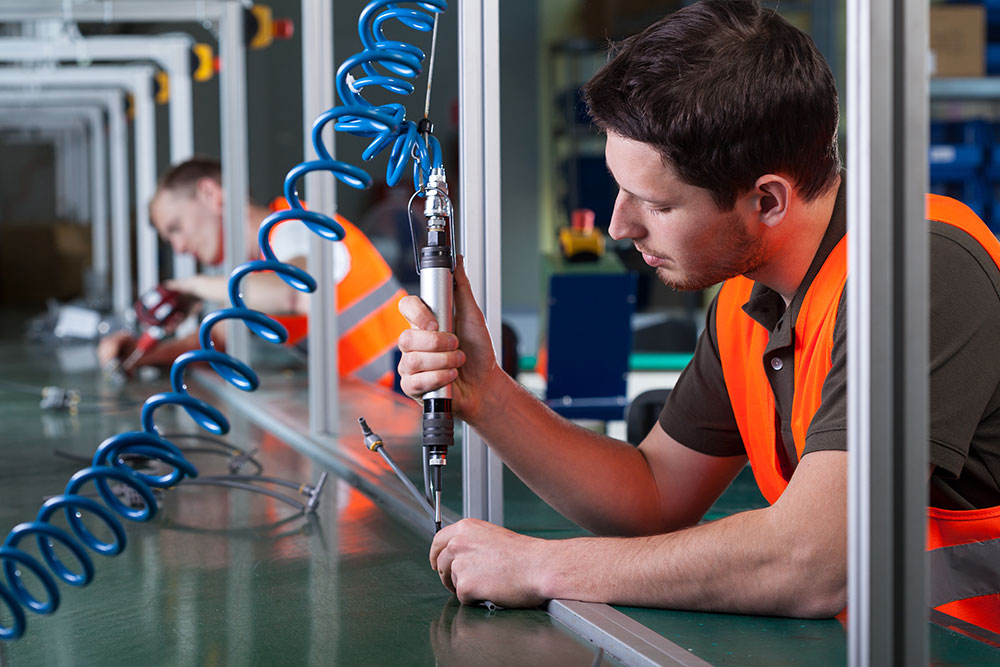Disclaimer: The information on our website is provided for general information purposes only. We make no representations or warranties of any kind, express or implied, about the completeness, accuracy, reliability, suitability or availability with respect to the website or the information contained on our website for any purpose. Any reliance on such information is therefore strictly at your own risk and we are not liable for any damages or losses arising out of or resulting from your reliance on any information contained on our website.
Assemblers and fabricators work assemble finished products that go into manufactured products. They also perform quality checks for mistakes or faulty components in the assembly process. The majority of assemblers and fabricators work in manufacturing plants which may require long periods of time sitting or standing.
Watch a video to learn more about a career in manufacturing.
How to Become an Assembler and Fabricator

The type of industry you works in may impact the education and qualifications level requirements to be an assembler and fabricator. For example, aerospace and defense industries or other more specialized jobs may require certification in soldering. Most often though, a high school diploma or the equivalent is sufficient. For more advanced assembly work, additional training and experience would be needed.
Workers are typically trained on-the-job. It’s reported that over 80% of team assemblers hold a high school diploma. Positions that work with aircraft and motor vehicle products, electrical, or electronic manufactures usually need more formal education from a technical school. Some employers may ask for an associate’s degree for more skilled assembler and fabrication jobs. Qualified applicants, including those with technical vocational training and certification, are likely to have the best job opportunities in growing, high-technology industries, such as aerospace and electro-medical devices manufacturing.
Job Description of an Assembler and Fabricator
Assemblers and fabricators can read and understand blueprints and schematics. They use various hand tools or machines to assemble parts and check for quality. Some assemblers and fabricators use computers, robots, programmable motion-control devices, and sensing technologies. Also, some assemblers and fabricators work with a team of people while others specialize in one type of product.
O*NET OnLine further breaks out assemblers and fabricators into another category, team assemblers. These assemblers work together during the assembly process and complete an item or task together, often rotating tasks and deciding how to maximize their efficiency. Team assemblers is considered to have a bright outlook so this career has a higher growth rate and salary associated with it.
There are also timing device assemblers that perform precision assembling, adjusting, or calibrating, within narrow tolerances, of timing devices such as digital clocks or timing devices with electrical or electronic components. Duties include but are no limited to assembling and installing parts of timepieces to complete mechanisms, using watchmakers’ tools and loupes. They observe timepiece mechanisms, components, and subassemblies to determine accuracy of movement or find causes of defects. Timing device assemblers test the operation and fit of parts and subassemblies. They may use electronic testing equipment, tweezers, watchmakers’ tools, and loupes.
Other specialized assemblers include Aircraft Structure, Surfaces, Rigging, and Systems Assemblers, Engine/ Machine Assemblers, Electrical/Electronic Equipment Assemblers, and Electromechanical Equipment Assemblers.
Article Citation
Bureau of Labor Statistics, U.S. Department of Labor, Occupational Outlook Handbook, Assemblers and Fabricators.
National Center for O*NET Development. 51-2092.00. O*NET OnLine. This page includes information from O*NET OnLine by the U.S. Department of Labor, Employment and Training Administration (USDOL/ETA). Used under the CC BY 4.0 license. O*NET® is a trademark of USDOL/ETA. RethinkOldSchool, Inc. has modified all or some of this information. USDOL/ETA has not approved, endorsed, or tested these modifications.
The career video is in the public domain from the U. S. Department of Labor, Employment and Training Administration.

